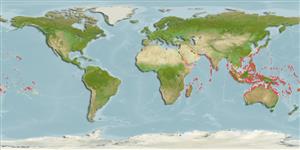>
Eupercaria/misc (Various families in series Eupercaria) >
Labridae (Wrasses) > Corinae
Etymology: Stethojulis: Greek, stetho, stethion = brest; literal = to prick a little breast + Greek, ioulis, a fish dealing with genera Coris or Thalassoma (Ref. 45335).
More on author: Bennett.
Environment: milieu / climate zone / profondeur / distribution range
Écologie
marin récifal; profondeur 2 - 15 m (Ref. 48636). Tropical; 30°N - 30°S
Indo-Pacific: Red Sea and East Africa south to Algoa Bay, South Africa (Ref. 4392) and east to the Marshall and Tuamoto islands. In the western Pacific, extends from Sagami Bay, Honshu to New South Wales (Australia).
Taille / Poids / Âge
Maturité: Lm ? range ? - ? cm
Max length : 15.0 cm TL mâle / non sexé; (Ref. 2334); 7.0 cm TL (female)
Épines dorsales (Total) : 9; Rayons mous dorsaux (Total) : 11; Épines anales: 3; Rayons mous anaux: 11. First spine of the anal fin is minute or imbedded (Ref. 1602). Terminal males of S. strigiventer and S. bandanensis are similar, but in S. strigiventer the uppermost lateral blue streak rather than the lowermost one extends to the tail (Ref. 1602).
Body shape (shape guide): fusiform / normal; Cross section: compressed.
Inhabits seagrass beds and areas of mixed sand, rubble, and algae of inner reef flats and shallow lagoons. Female length is from Ref. 9137. Swims in small aggregations over large areas. Maximum depth reported taken from Ref. 48636.
Life cycle and mating behavior
Maturité | Reproduction | Frai | Œufs | Fécondité | Larves
Oviparous, distinct pairing during breeding (Ref. 205).
Randall, J.E., 2000. Revision of the Indo-Pacific labrid fishes of the genus Stethojulis, with descriptions of two new species. Indo-Pac. Fish. (31):42 p. (Ref. 36378)
Statut dans la liste rouge de l'IUCN (Ref. 130435: Version 2025-1)
Menace pour l'homme
Harmless
Utilisations par l'homme
Pêcheries: commercial; Aquarium: Commercial
Outils
Articles particuliers
Télécharger en XML
Sources Internet
Estimates based on models
Preferred temperature (Réf.
123201): 24.9 - 29.3, mean 28.4 °C (based on 3102 cells).
Phylogenetic diversity index (Réf.
82804): PD
50 = 0.5010 [Uniqueness, from 0.5 = low to 2.0 = high].
Bayesian length-weight: a=0.00813 (0.00490 - 0.01347), b=3.00 (2.86 - 3.14), in cm total length, based on LWR estimates for this species & Genus-body shape (Ref.
93245).
Niveau trophique (Réf.
69278): 3.1 ±0.1 se; based on diet studies.
Résilience (Réf.
120179): Haut, temps minimum de doublement de population inférieur à 15 mois (Preliminary K or Fecundity.).
Fishing Vulnerability (Ref.
59153): Low vulnerability (10 of 100).
🛈
Nutrients (Ref.
124155): Calcium = 95.3 [55.1, 161.4] mg/100g; Iron = 0.752 [0.432, 1.407] mg/100g; Protein = 18.4 [15.5, 20.6] %; Omega3 = 0.14 [0.09, 0.22] g/100g; Selenium = 20.9 [12.7, 37.6] μg/100g; VitaminA = 136 [43, 504] μg/100g; Zinc = 1.9 [1.3, 3.1] mg/100g (wet weight);
